|
|
Newsletter November 2019
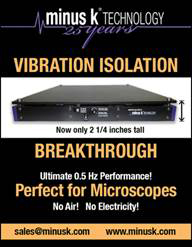
 |
|
Vibration Criterion (VC)
Curves-Lab Analysis
Codes and curve descriptions for different
vibration environments
and enviromental solutions.
The VC
(Vibration Criteria) curves were developed in the early 1980s by Eric Ungar and
Colin Gordon. They were originally developed as a generic vibration criteria
for vibration-sensitive equipment for use in the semiconductor, medical and
biopharmaceutical industries, but have found application in a wide variety of
technological applications.
The criteria takes the form of a set of
one-third octave band velocity spectra, together with the International
Standards Organization (ISO) guidelines for the effects of vibration on people
in buildings. The criteria apply to vibration as measured in the vertical and
two horizontal directions.
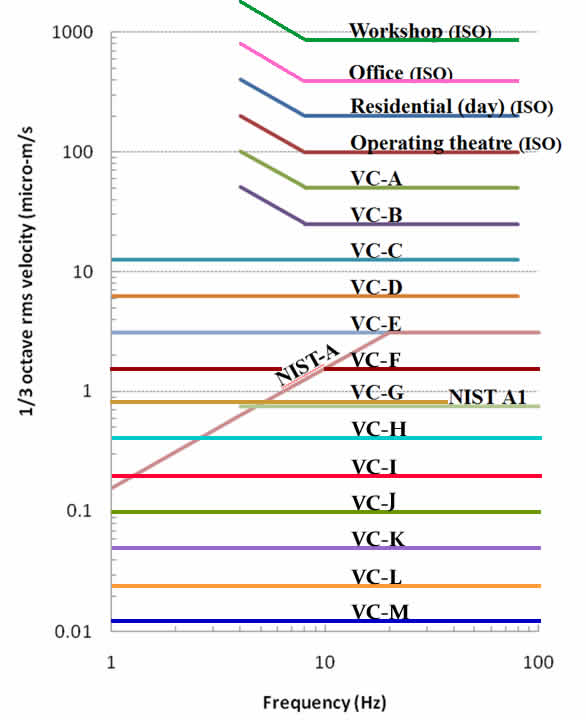
The
NIST-A criterion was developed for metrology, but has gained popularity within
the nanotechnology community. The NIST-A criterion is a very difficult
criterion to meet at some sites with significant low-frequency
vibrations.
The VC curves are now widely accepted throughout the world
as a basis for designing a facility to meet the requirements of a group of
highly vibration sensitive equipment used close together.
University of
Michigans Ultra-Low Vibration Lab (ULVL) was completed in 2014. After the
construction, a vibration survey was done on the Ultra-Low Vibration Lab
chambers. The measurements demonstrated that even when a single vehicle was
driving on a nearby street, the vibrations exceeded the NIST-A specifications
necessary for the ULVL.
The University of Michigan ordered seven
customized tabletops and 31 custom Minus K Negative-Stiffness vibration
isolators with pedestals provided for the eight Ultra-Low Vibration Lab
chambers.
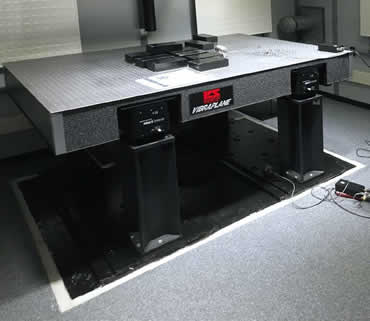
Customized Minus K
Technology Negative-Stiffness vibration isolation table installed in one of the
Ultra-Low Vibration Lab chambers
The
final vibration survey by Colin Gordon Associates (CGA), after installation of
the customized Minus K Negative-Stiffness isolators and tables, showed the
measured vibration levels in all ULVL chambers from VC-K to VC-M at frequencies
above 2.5 Hz, well below the NIST-A Vibration Criterion required.
"VC-M
is the lowest we have ever measured, though we werent able to measure below 2.5
Hz because our most sensitive sensor wont go lower, due to sensor noise floor,"
said Hal Amick, Vice President of Colin Gordon Associates.
The updated
VC Curve on Minus K's
website shows these lower curve levels that were measured by CGA
and have already assisted University of Michigans ULVL with two major
scientific milestones.
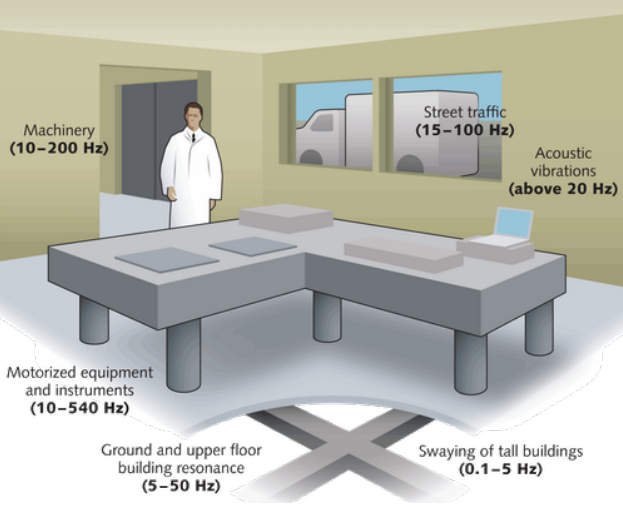
Vibration site surveys can tell you a
lot about how to
specify equipment for vibration isolation in your
laboratory.
| Curve
Criterion |
Amplitude1
µm/s
(µin/s) |
Detail Size2
µm
|
Description of
Use |
| Workshop (ISO) |
800( 32,000) |
N/A |
Distinctly perceptible vibration.
Appropriate to workshops and non-sensitive areas. |
| Office (ISO) |
400 (16,000) |
N/A |
Perceptible vibration. Appropriate to
offices and non-sensitive areas |
| Residential Day (ISO) |
200 (8000) |
75 |
Barely perceptible vibration. Appropriate
to sleep areas in most instances. Usually adequate for computer equipment,
hospital recovery rooms, semiconductor probe test equipment and microscopes
less than 40x. |
| Op. Theatre (ISO) |
100 (4000) |
25 |
Vibration not perceptible. Suitable in
most instances for surgical suites, microscopes to 100X and for other equipment
of low sensitivity. |
| VC-A |
50 (2000) |
8 |
Adequate in most instances for optical
microscopes to 400X, microbalances, optical balances, proximity and projection
aligners, etc. |
| VC-B |
25 (1000) |
3 |
Appropriate for inspection and lithography
(including steppers) to 3 µm line widths.. |
| VC-C |
12.5 (500) |
1 - 3 |
Appropriate standard for optical
microscopes to 1000X, inspection and lithography inspection equipment
(including moderately sensitive electron microscopes) to 1 µm detail
size, TFT-LCD stepper/scanner processes. |
| VC-D |
6.25 (250) |
0.1 - 0.3 |
Suitable in most instances for the most
demanding equipment including electron microscopes (TEMs and SEMs) and E-Beam
systems.. |
| VC-E |
3.12 (125) |
< 0.1 |
A challenging criterion to achieve.
Assumed to be adequate for the most demanding of sensitive systems including
long path, laser-based, small target systems, E-Beam lithography systems
working at nanometer scales, and other systems requiring extraordinary dynamic
stability. |
| VC-F |
1.56 (62.5) |
N/A |
Appropriate for extremely quiet research
spaces; generally difficult to achieve in most instances, especially
cleanrooms. Not recommended for use as a design criterion, only for
evaluation. |
| VC-G |
.78 (31.3) |
N/A |
Appropriate for extremely quiet research
spaces; generally difficult to achieve in most instances, especially
cleanrooms. Not recommended for use as a design criterion, only for
evaluation. |
| NIST-A |
|
|
NIST-A criterion is identical to the VC-E
curve at frequencies above 20 Hz, but maintains constant displacement at
frequencies below this. 0.025 µm or 25 nm between 1 and 20 Hz; 3.1
µm /s (125 µ in /s) between 20 and 100 Hz |
| NIST-A1 |
|
|
NIST-A1 criterion requires an RMS velocity
of 3 µm/sec (118 µin./sec) for frequencies less than 4 Hz, and 0.75
µm/sec (29.5 µin./sec) velocity for frequencies 4 Hz < f <
100 Hz |
| VC-H |
.39 (15.63) |
N/A |
Appropriate for extremely quiet research
spaces; generally difficult to achieve in most instances, especially
cleanrooms. Not recommended for use as a design criterion, only for
evaluation. |
| VC-I |
.195 (7.81) |
N/A |
Appropriate for extremely quiet research
spaces; generally difficult to achieve in most instances, especially
cleanrooms. Not recommended for use as a design criterion, only for
evaluation. |
| VC-J |
.097 (3.9) |
N/A |
Appropriate for extremely quiet research
spaces; generally difficult to achieve in most instances, especially
cleanrooms. Not recommended for use as a design criterion, only for
evaluation. |
| VC-K |
.048 (1.95) |
N/A |
Appropriate for extremely quiet research
spaces; generally difficult to achieve in most instances, especially
cleanrooms. Not recommended for use as a design criterion, only for
evaluation. |
| VC-L |
.024 (0.98) |
N/A |
Appropriate for extremely quiet research
spaces; generally difficult to achieve in most instances, especially
cleanrooms. Not recommended for use as a design criterion, only for
evaluation. |
| VC-M |
.012 (0.49) |
N/A |
Appropriate for extremely quiet research
spaces; generally difficult to achieve in most instances, especially
cleanrooms. Not recommended for use as a design criterion, only for
evaluation. |
| 1 As
measured in one-third octave bands of frequency over the frequency range 8 to
80 Hz (VC-A and VC-B) or 1 to 80 Hz (VC-C through VC-G) |
| 2
The detail size refers to line width in the case of microelectronics
fabrication, the particle (cell) size in the case of medical and pharmaceutical
research, etc. It is not relevant to imaging associated with probe
technologies, AFMs, and nanotechnology. |
|
The information given in
this table is for guidance only. In most instances, it is recommended that the
advice of someone knowledgeable about applications and vibration requirements
of the equipment and processes be sought. |
This table is a reference of Colin
Gordon Associates ,except (3&4).
3 Vibro-Acoustic Consultants,
4 Purdue
University Libraries.. |
| 5
NIST-A1 criterion was for the NIST AML (0.75 mm/s at frequencies between 4 and
100 Hz). NIST AML has a quantity of vibration-isolated spaces, created by
placing large concrete blocks on air springs. If these had been used in a space
just meeting NIST-A, then the performance would be on the order of NIST-A1,
accounting for degradation at internal resonances. This was more of a
philosophy than a set criterion amplitude. |
Updated
VC Curve on Minus K's website... |
|
Featured Product: WS-4 Compact Vibration Isolation
Table
- Vertical natural frequency
of 1/2 Hz or less can be achieved over the entire load range.
- Horizontal natural
frequency is load dependent. 1/2 Hz or less can be achieved at or near the
nominal load.
- Horizontal natural
frequency is load dependent. 1/2 Hz or less can be achieved at or near the
nominal load.
- Dimensions: 24" W x 24" D
x 23" H
(610mm W x 610mm D x 533mm H)
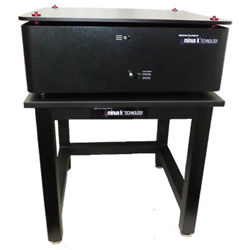 A cost
effective vibration isolation table for weight loads up to 1000 lb. and 1/2 Hz
performance vertical and horizontal. A cost
effective vibration isolation table for weight loads up to 1000 lb. and 1/2 Hz
performance vertical and horizontal.
The stand has been designed with a
damped Phenolic top which includes locating holes for the leveling feet of the
BM-1 and
BM-4.
Pricing & Specifications
|
|
How They
Work>>Negative-Stiffness Vibration Isolators
Minus K®
vibration isolators employ a revolutionary concept in
low-frequency vibration isolation. Vertical-motion isolation is provided by a
stiff spring that supports a weight load, combined with a negative-stiffness
mechanism (NSM). The net vertical stiffness is made very low without affecting
the static load-supporting capability of the spring. Beam-columns connected in
series with the vertical-motion isolator provide horizontal-motion isolation.
The horizontal stiffness of the beam-columns is reduced by the "beam-column"
effect. (A beam-column behaves as a spring combined with an NSM.) The result is
a compact
passive isolator capable of very low vertical and
horizontal natural frequencies and very high internal structural
frequencies.
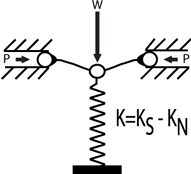
Figure 1 |
|
Minus K®
isolators typically use three isolators stacked in series:
A
tilt-motion isolator on top of a horizontal-motion isolator on top of a
vertical-motion isolator. A vertical-motion isolator is shown in
Figure
1. It uses a conventional spring connected to an NSM consisting of two
flexures connected at their inner ends to the spring and supported at their
outer ends, and loaded in compression by forces P. The spring is compressed by
weight W to the operating position of the isolator, as shown in Figure 1. The
stiffness of the isolator is K=KS-KN where KS is the spring stiffness and KN is
the magnitude of a negative stiffness which is a function of the design of the
flexures and the load P. The isolator stiffness can be made to approach zero
while the spring supports the weight W. |
A
horizontal-motion isolation system consisting of two beam-column isolators is
shown in Figure 2. Each isolator behaves like two fixed-free beam
columns loaded axially by a weight load W. Without the weight load the
beam-columns have horizontal stiffness KS. With the weight load the lateral
bending stiffness is reduced by the "beam-column" effect. This behavior is
equivalent to a horizontal spring combined with an NSM so that the horizontal
stiffness is K=KS-KN, and KN is the magnitude of the beam-column effect.
Horizontal stiffness can be made to approach zero by loading the beam-columns
to approach their critical buckling load.
Full article +
more images...
Performance... |
|
Custom Vibration Isolation
Systems
Minus K engineers can design a variety of custom vibration
isolation systems. Frequently these are modifications of other designs such as
changing the load capacity of an
SM-1 isolator, or the capacity, size and
isolator locations on a
FP-1. 
Custom table top with four resessed Minus K
CM-1s and pedestals
|
Some other custom modifications and capabilities
include:
- Different
vertical, horizontal or tilt stiffness in an isolator
- Different
vertical, horizontal or tilt damping in an isolator
- Vacuum
compatibility
- Mildly
magnetic
- Heavy load
capacities
(Six 10,000 lb
isolators for NASA's James Webb
Space Telescope Ground
Testing).
- Large
displacements
- Large
temperature variations
- Compact systems
(e.g., a seven-inch cubic 1/2 Hz isolator for a 700 lb payload;
a six-inch
diameter by 4-inches tall 1/2 Hz vibration isolation platform for a 3 lb
payload.)
- Vertical
auto-adjust feature to automatically adjust for change in payload
weight.
- Lock-unlock
feature implemented manually with a switch or automatically
with signals,
from a stage motion control system, for example.
|
|
Audio Reproduction & Turntable
Vibration Isolation
Platforms, Tables, & Integrated
Systems
|
Since the early 2000s, Minus K Technology, the developer of
Negative-Stiffness vibration isolation, has released several vibration
isolation platforms for the high-end audio market. These products have been
accepted with high acclaim by audiophiles and audio system manufacturers
worldwide.
The industry's highest performing vibration isolation system
is available in a cost-effective, low-height platform. The
BM-8 Series vibration
isolation platform offers true ½-Hz isolation performance vertical and
1.5 Hz horizontal and is easy to use. No air or electric power is required,
there is no maintenance and nothing to wear out. It is 18Wx20Dx4.6H and is
available with nominal load capacities from 25 to 250 lbs. It is ideal for
turntables, CD transports and other audio components.
The Helix One®
and Helix Two® turntables from Dohmann Audio, for example, come fully
integrated with Negative-Stiffness vibration isolation.
Doehmann Helix 1 (BM-8 fully integrated)
Doehmann Helix 2 (BM-10 fully integrated)
“The ability
of Negative-Stiffness to deal with vibration and resonance is unsurpassed, and
allows the music to be enjoyed with an outstanding level of
realism.
Analog audiophile aficionados talk about blackberry notes,
where the base is too prominent and muddy, explained Dohmann. This is often
caused by a reinjection of vibration into the playback mechanism, adding to the
amplitude of the needle movement and creating more signal that what is
physically in the groove. But Negative-Stiffness vibration isolation cleans
this up, so that the base is more natural. The timbre of the instrument used to
produce the base, whether a string, piano or drum, sounds more like the real
thing. It enables a sense of peace and calm to the playback."
-
Mark Döhmann, Founder Döhmann Audio |
The latest generation of Negative-Stiffness vibration isolation
technology, embodied within the new ultra-thin, low-hieght Minus K
CT-1, truly represents
a significant advance in sound quality in a very compact package for high-end
audio perfectionists.
SAT (Swedish Analog Technologies) XD1 Record Player
System
with Minus K
CT-1 [integrated into the
platform]
|
“I have now tried the
CT-1 with the SAT top
platform the results are spectacular! I took a look at the mechanism inside of
the CT-1 and I have to say I am very impressed with the ingenious work you have
done. It provides most of its big brothers performance in an extremely compact
package that looks very slick. The arrangement and the finish of the mechanism
is an engineers dream and it should be proudly displayed. The equipment
supported by the CT-1 is well isolated from vibrations from 0.7 to 100 Hz, with
much deeper, clearer base and more information in the lower frequencies. The
CT-1 makes a huge difference in sound quality."
- Marc Gomez,
President / Swedish Analog Technologies SAT |
The
BM-1 Series platform
offers Minus K's signature 0.5 Hz performance, both vertical and horizontal,
and is available for larger and much heavier audio components.
The
BM-10 Series offers
smaller horzontal dementions at 12.2 W x 12.2 D x 4.6 H (310mm W x 310mm D x
117mm H).
More images, plus reviews and
testimonials...
|
|

Microscopy Vibration
Isolation
Tables, Platforms, Benchtops & Custom Systems for
SEM, AFM, TEM, SPM, STM, STEM, NSOM-SNOM
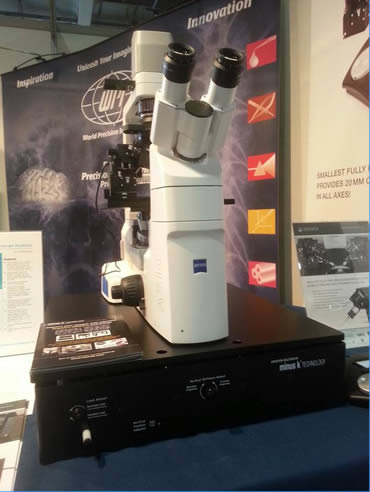
Zeiss Axio
Obersver Z1 AFM
on a Minus K
BM-8
|
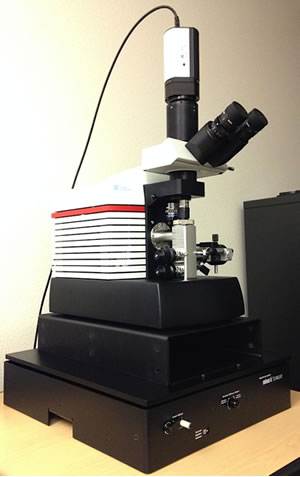
Delong LVEM5
Desktop SEM
on a Minus K
BM-8
|
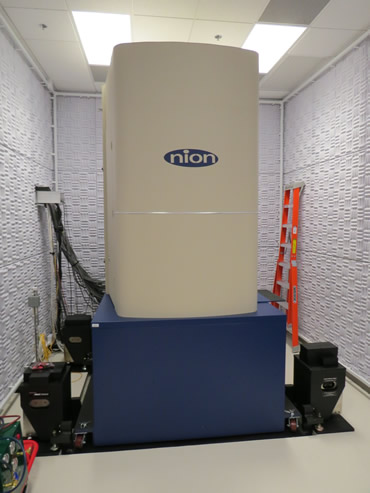
Nion STEM on a
four-isolator
Minus K
FP-1
|
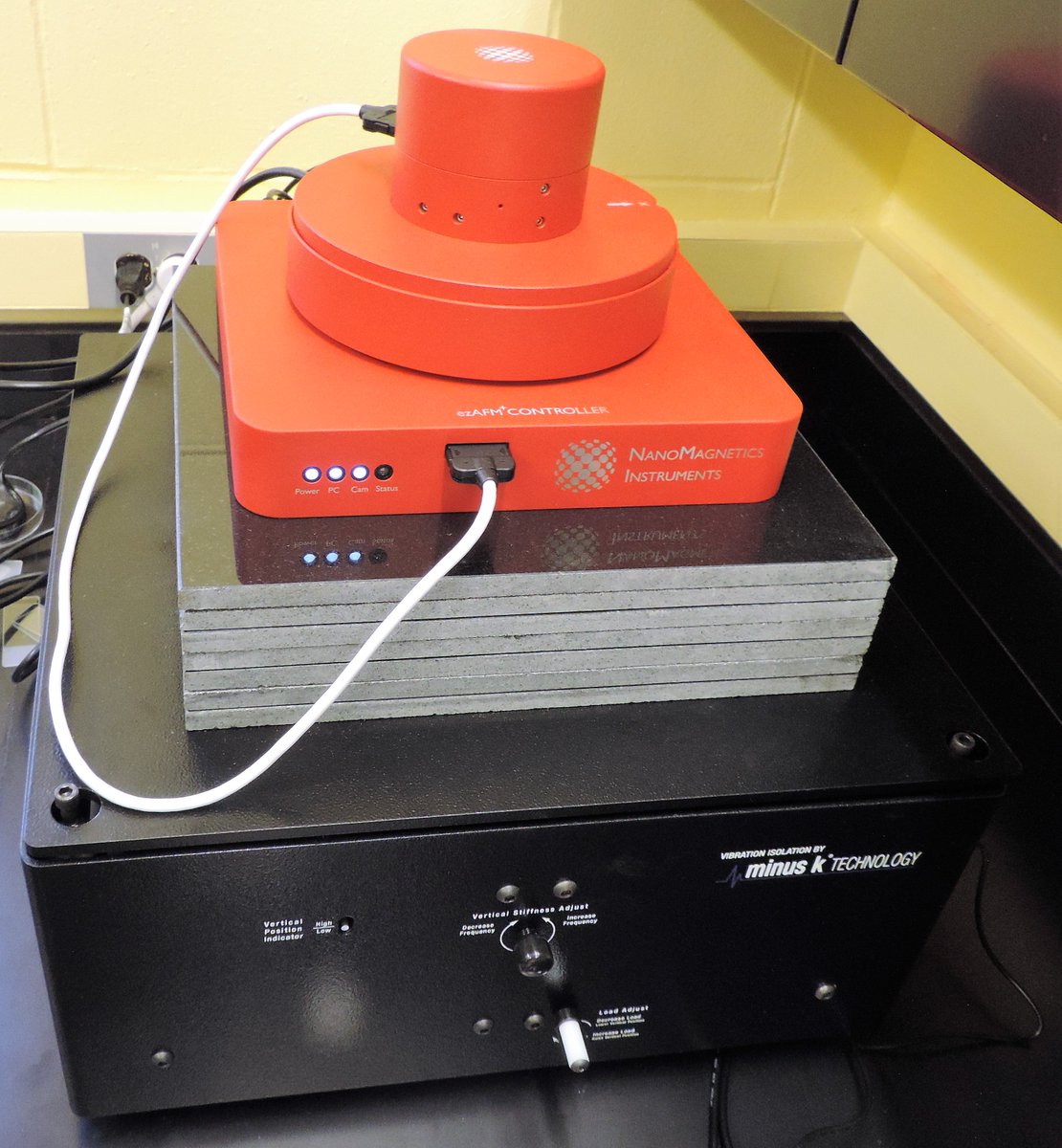
NanoMagnetics
ezAFM
on a Minus K
50BM-4
|
|
Many
of our clients' microscopes have nano and micro vibration isolation
requirements that are unparalleled in the metrology world (for
brain
research and at
NASA as examples). Minus K's negative
stiffness and "passive" verses "active" technology, enables microscopes to
achieve their highest level of performance. Our
isolators and
custom systems provide the performance of an
ideal bungee system and the convenience of a bench top system without any of
the problems associated with many of them, including air tables.
From
the ubiquitous bungee suspension systems, to large beds of sand on inner tubes,
there have been many attempts at achieving the ultimate isolation. Air tables
have been used with some success. However, our negative-stiffness isolators
provide superior isolation control and performance while offering better ease
of use and no facility requirements. We even have the flexibility of custom
tailoring resonant frequencies vertically, horizontally and in tilt to your
liking.
Small "active" systems (as opposed to our "passive" systems) are
sometimes used. However, those have several drawbacks:
- They are
expensive and fragile.
- They are
subject to the noise floor of every component in the entire feedback loop plus
AC line noise.
- They
have a limited dynamic range, typically only a few thousandths of an inch. If
this is exceeded (very easy to do) the isolator goes into positive feedback and
you have a very expensive noise generator underneath your SPM.
- They
have to be sitting on an infinitely rigid structure to work at their
theoretical best. Obviously, infinitely rigid structures are not easy to find
in most labs. The result is that the isolator is not always doing what you
think it's doing.
|
Our
isolators give you the best possible
performance in all axes, from high to low frequency isolation. They provide the
performance of an ideal bungee system and the convenience of a bench top system
without any of the problems associated with any of them, including air tables.
We enable our users to achieve the highest level of noise performance possible.
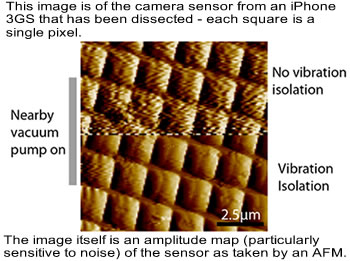
|
|

|
|

 |
|
|
